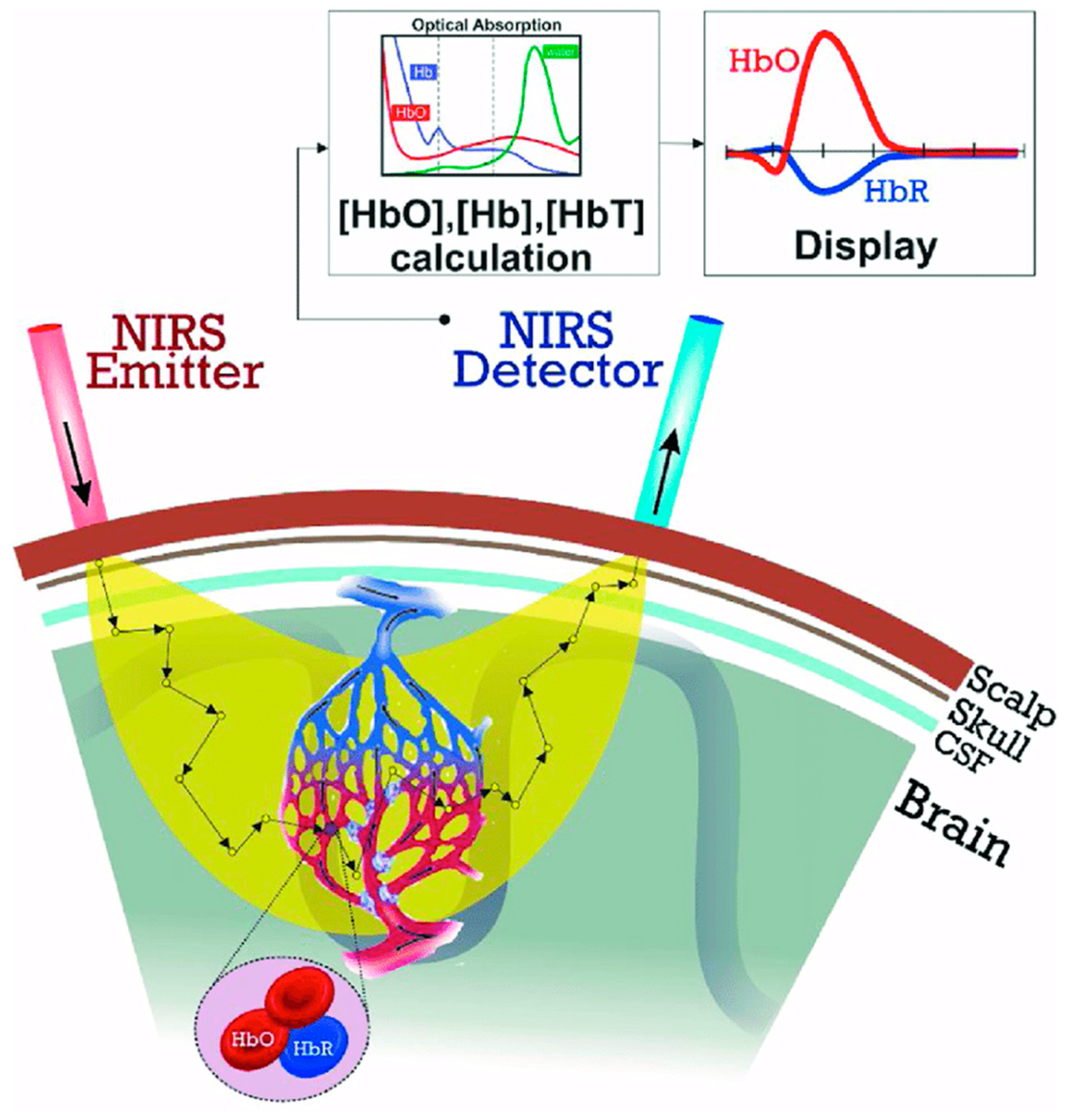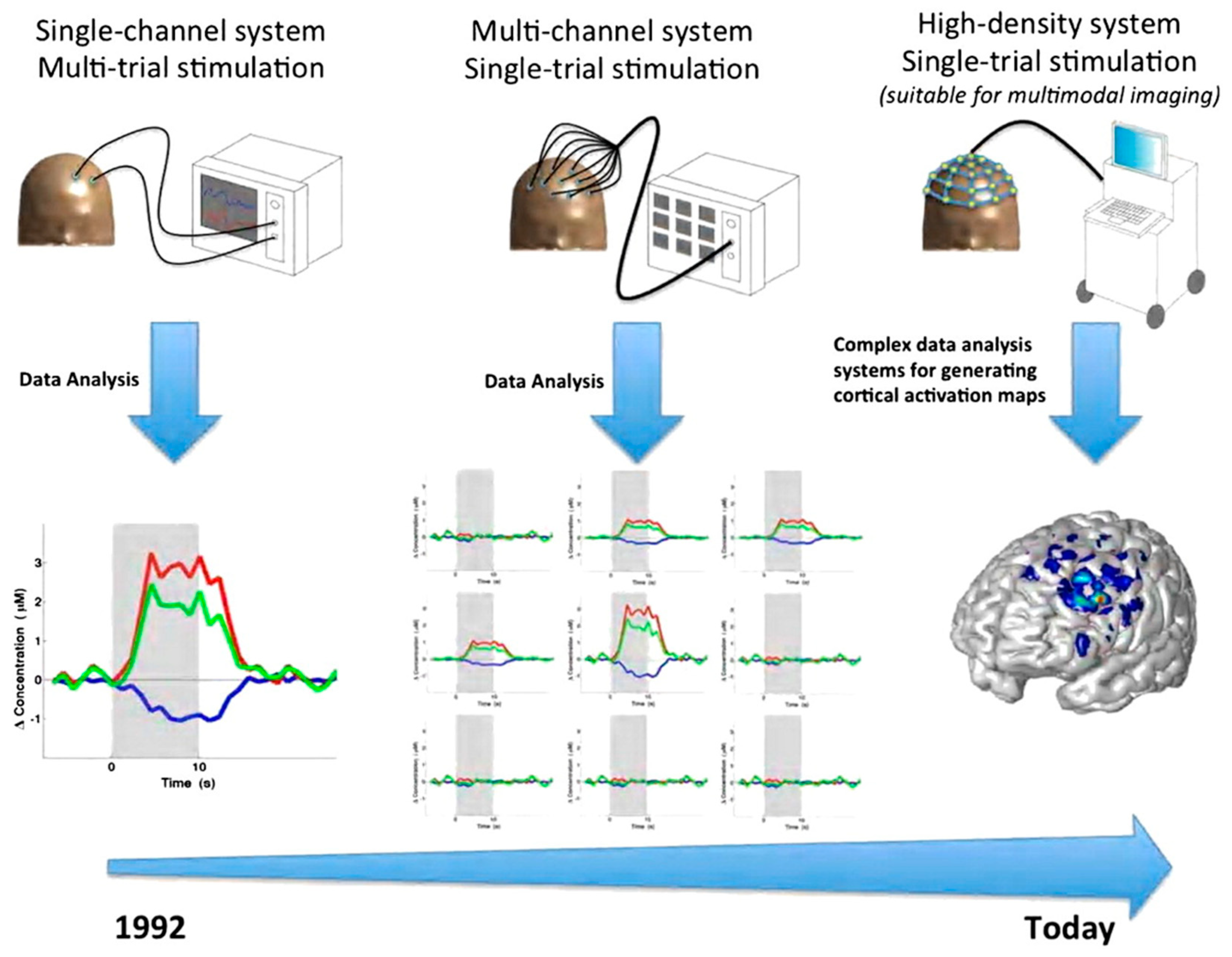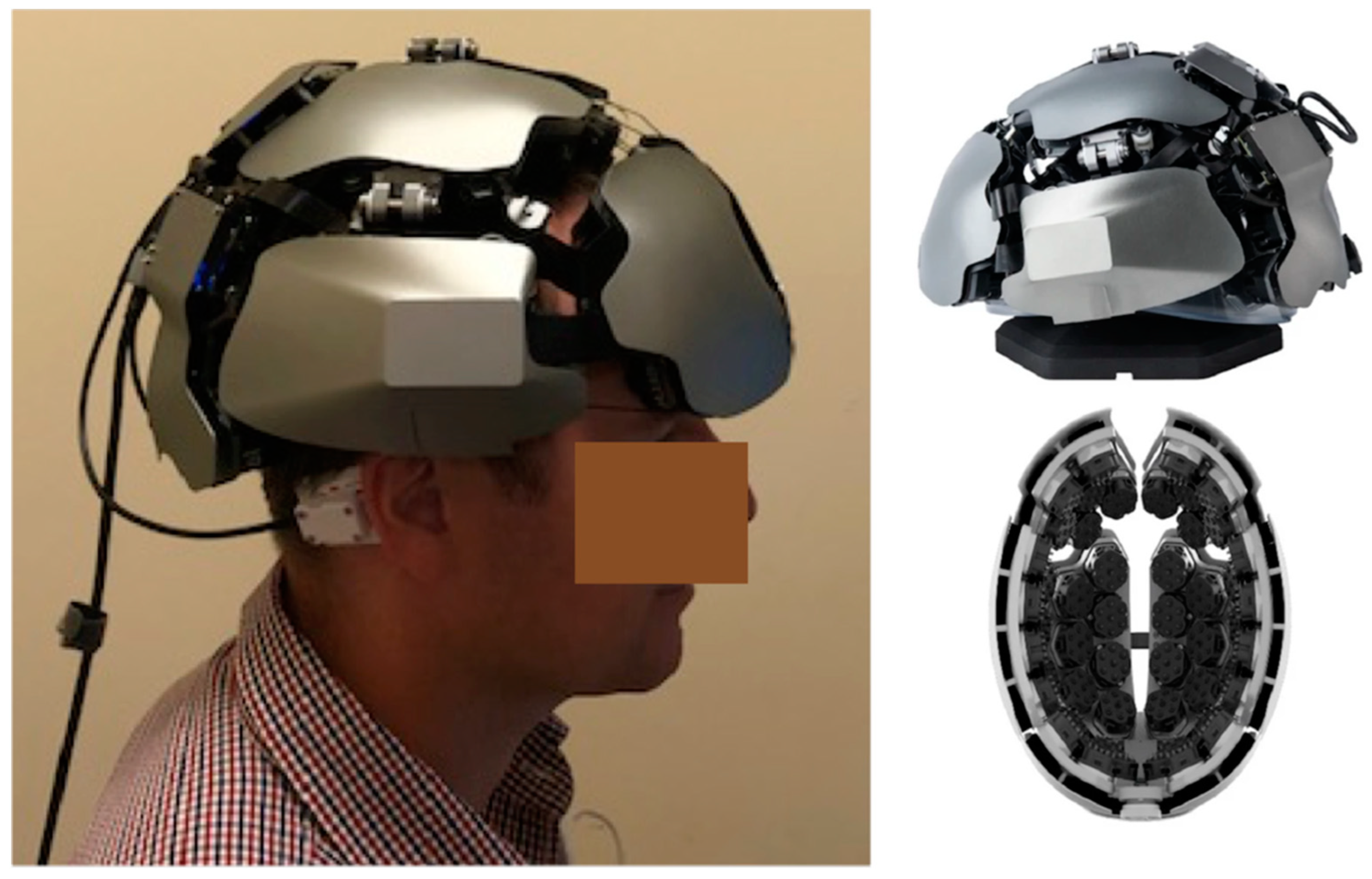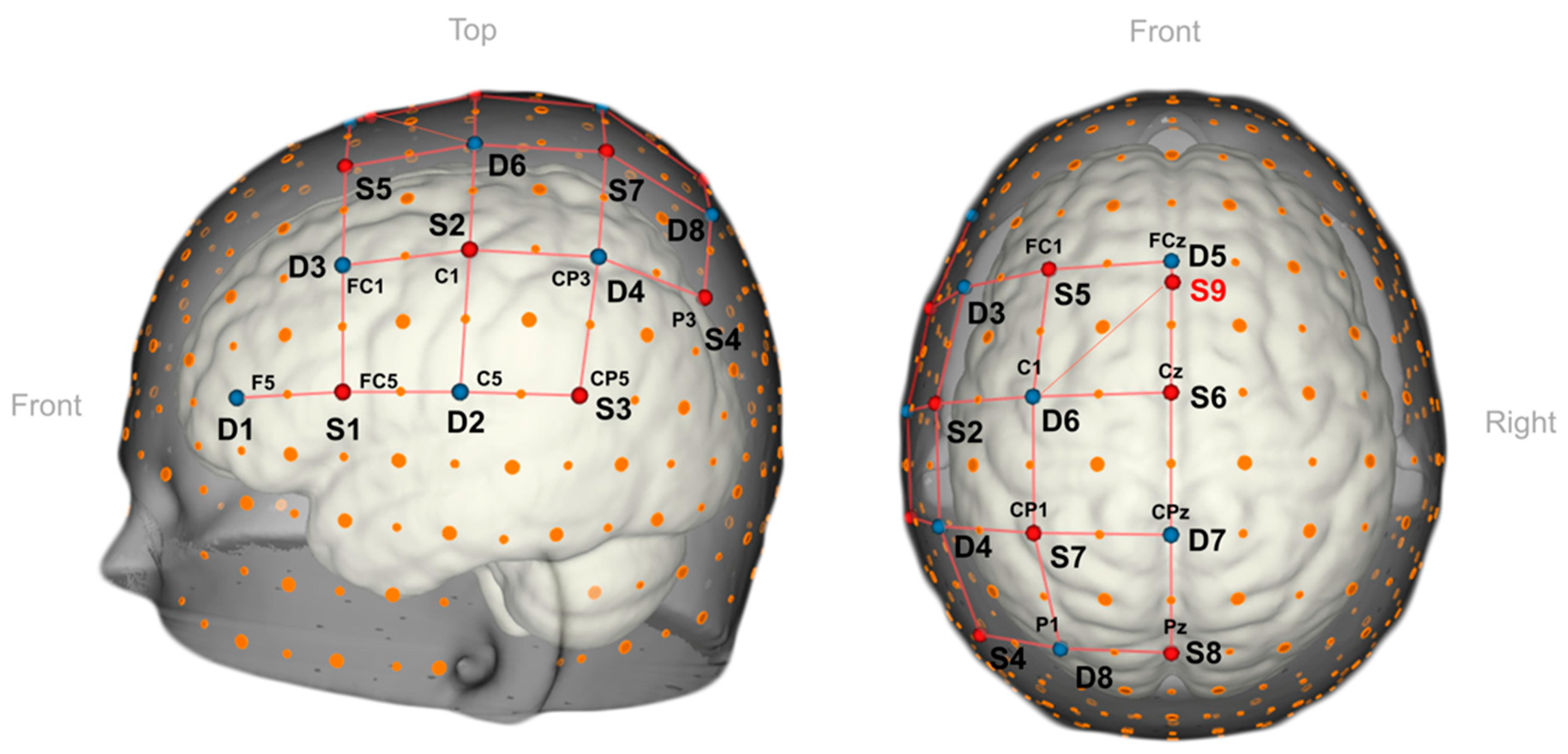Functional Near-Infrared Spectrometry as a Useful Diagnostic Tool for Understanding the Visual System: A Review
Abstract
:1. Introduction
2. Data Sources and Search Strategy
3. Considerations of fNIRS
3.1. Mechanism of Action
3.2. Historical Development
3.3. Advantages and Disadvantages
3.4. Application in Other Fields
4. Application to the Visual System
4.1. Understanding the Eye
4.2. Eye Function
4.3. Eye Disease
4.4. Visual Cortex
4.5. Visual Stimuli
5. Future of fNIRS Technology
5.1. Virtual Reality
5.2. Augmented Reality
5.3. Artificial Intelligence
6. Conclusions
Funding
Acknowledgments
Conflicts of Interest
References
- Armstrong, R.A.; Cubbidge, R.C. 1—The Eye and Vision: An Overview. In Handbook of Nutrition, Diet, and the Eye, 2nd ed.; Preedy, V.R., Watson, R.R., Eds.; Academic Press: Cambridge, MA, USA, 2019; pp. 3–14. [Google Scholar]
- Wijeakumar, S.; Shahani, U.; Simpson, W.A.; McCulloch, D.L. Localization of hemodynamic responses to simple visual stimulation: An fNIRS study. Invest. Ophthalmol. Vis. Sci. 2012, 53, 2266–2273. [Google Scholar] [CrossRef] [PubMed]
- Bastien, D.; Gallagher, A.; Tremblay, J.; Vannasing, P.; Thériault, M.; Lassonde, M.; Lepore, F. Specific functional asymmetries of the human visual cortex revealed by functional near-infrared spectroscopy. Brain Res. 2012, 1431, 62–68. [Google Scholar] [CrossRef] [PubMed]
- Chen, L.C.; Sandmann, P.; Thorne, J.D.; Herrmann, C.S.; Debener, S. Association of Concurrent fNIRS and EEG Signatures in Response to Auditory and Visual Stimuli. Brain Topogr. 2015, 28, 710–725. [Google Scholar] [CrossRef] [PubMed]
- Pinti, P.; Tachtsidis, I.; Hamilton, A.; Hirsch, J.; Aichelburg, C.; Gilbert, S.; Burgess, P.W. The present and future use of functional near-infrared spectroscopy (fNIRS) for cognitive neuroscience. Ann. N. Y. Acad. Sci. 2020, 1464, 5–29. [Google Scholar] [CrossRef]
- Rahman, M.A.; Siddik, A.B.; Ghosh, T.K.; Khanam, F.; Ahmad, M. A Narrative Review on Clinical Applications of fNIRS. J. Digit. Imaging 2020, 33, 1167–1184. [Google Scholar] [CrossRef]
- Paulmurugan, K.; Vijayaragavan, V.; Ghosh, S.; Padmanabhan, P.; Gulyás, B. Brain-Computer Interfacing Using Functional Near-Infrared Spectroscopy (fNIRS). Biosensors 2021, 11, 389. [Google Scholar] [CrossRef]
- Chiarelli, A.M.; Perpetuini, D.; Croce, P.; Greco, G.; Mistretta, L.; Rizzo, R.; Vinciguerra, V.; Romeo, M.F.; Zappasodi, F.; Merla, A.; et al. Fiberless, Multi-Channel fNIRS-EEG System Based on Silicon Photomultipliers: Towards Sensitive and Ecological Mapping of Brain Activity and Neurovascular Coupling. Sensors 2020, 20, 2831. [Google Scholar] [CrossRef]
- Chen, W.L.; Wagner, J.; Heugel, N.; Sugar, J.; Lee, Y.W.; Conant, L.; Malloy, M.; Heffernan, J.; Quirk, B.; Zinos, A.; et al. Functional Near-Infrared Spectroscopy and Its Clinical Application in the Field of Neuroscience: Advances and Future Directions. Front. Neurosci. 2020, 14, 724. [Google Scholar] [CrossRef]
- Mohammadi-Nejad, A.R.; Mahmoudzadeh, M.; Hassanpour, M.S.; Wallois, F.; Muzik, O.; Papadelis, C.; Hansen, A.; Soltanian-Zadeh, H.; Gelovani, J.; Nasiriavanaki, M. Neonatal brain resting-state functional connectivity imaging modalities. Photoacoustics 2018, 10, 1–19. [Google Scholar] [CrossRef]
- Schroeter, M.L.; Bücheler, M.M.; Müller, K.; Uludağ, K.; Obrig, H.; Lohmann, G.; Tittgemeyer, M.; Villringer, A.; von Cramon, D.Y. Towards a standard analysis for functional near-infrared imaging. Neuroimage 2004, 21, 283–290. [Google Scholar] [CrossRef]
- Ban, H.Y.; Barrett, G.M.; Borisevich, A.; Chaturvedi, A.; Dahle, J.L.; Dehghani, H.; Dubois, J.; Field, R.M.; Gopalakrishnan, V.; Gundran, A.; et al. Kernel Flow: A high channel count scalable time-domain functional near-infrared spectroscopy system. J. Biomed. Opt. 2022, 27, 074710. [Google Scholar] [CrossRef] [PubMed]
- Ferrari, M.; Quaresima, V. A brief review on the history of human functional near-infrared spectroscopy (fNIRS) development and fields of application. Neuroimage 2012, 63, 921–935. [Google Scholar] [CrossRef] [PubMed]
- Hu, X.S.; Nascimento, T.D.; DaSilva, A.F. Shedding light on pain for the clinic: A comprehensive review of using functional near-infrared spectroscopy to monitor its process in the brain. Pain 2021, 162, 2805–2820. [Google Scholar] [CrossRef] [PubMed]
- Castillo, A.; Dubois, J.; Field, R.M.; Fishburn, F.; Gundran, A.; Ho, W.C.; Jawhar, S.; Kates-Harbeck, J.; Aghajan, Z.M.; Miller, N.; et al. Measuring acute effects of subanesthetic ketamine on cerebrovascular hemodynamics in humans using TD-fNIRS. Sci. Rep. 2023, 13, 11665. [Google Scholar] [CrossRef] [PubMed]
- Kashou, N.H.; Xu, R.; Roberts, C.J.; Leguire, L.E. Using FMRI and FNIRS for localization and monitoring of visual cortex activities. Annu. Int. Conf. IEEE Eng. Med. Biol. Soc. 2007, 2007, 2634–2638. [Google Scholar] [CrossRef]
- Matsuo, K.; Ban, R.; Hama, Y.; Yuzuriha, S. Eyelid Opening with Trigeminal Proprioceptive Activation Regulates a Brainstem Arousal Mechanism. PLoS ONE 2015, 10, e0134659. [Google Scholar] [CrossRef]
- Iwata, Y.; Handa, T.; Ishikawa, H.; Shoji, N.; Shimizu, K. Efficacy of an Amblyopia Treatment Program with Both Eyes Open: A Functional Near-Infrared Spectroscopy Study. Am. Orthopt. J. 2016, 66, 87–91. [Google Scholar] [CrossRef]
- Yamakawa, M.; Tachibana, A.; Tatsumoto, M.; Okajima, K.; Ueda, S.; Hirata, K. Hemodynamic responses related to intrinsically photosensitive retinal ganglion cells in migraine. Neurosci. Res. 2020, 160, 57–64. [Google Scholar] [CrossRef]
- Zhang, Y.; Lin, X.; Bi, A.; Cao, N.; Zhang, T.; Wang, S.; Wen, Y.; Bi, H. Changes in visual cortical function in moderately myopic patients: A functional near-infrared spectroscopy study. Ophthalmic Physiol. Opt. 2022, 42, 36–47. [Google Scholar] [CrossRef]
- Yaramothu, C.; Li, X.; Morales, C.; Alvarez, T.L. Reliability of Frontal Eye Fields Activation and Very Low-Frequency Oscillations Observed during Vergence Eye Movements: An fNIRS Study. Sci. Rep. 2020, 10, 712. [Google Scholar] [CrossRef]
- Cai, T.; Zhu, H.; Xu, J.; Wu, S.; Li, X.; He, S. Human cortical neural correlates of visual fatigue during binocular depth perception: An fNIRS study. PLoS ONE 2017, 12, e0172426. [Google Scholar] [CrossRef] [PubMed]
- Hoppes, C.W.; Sparto, P.J.; Whitney, S.L.; Furman, J.M.; Huppert, T.J. Changes in cerebral activation in individuals with and without visual vertigo during optic flow: A functional near-infrared spectroscopy study. Neuroimage Clin. 2018, 20, 655–663. [Google Scholar] [CrossRef] [PubMed]
- Gagrani, M.; Faiq, M.A.; Sidhu, T.; Dada, R.; Yadav, R.K.; Sihota, R.; Kochhar, K.P.; Verma, R.; Dada, T. Meditation enhances brain oxygenation, upregulates BDNF and improves quality of life in patients with primary open angle glaucoma: A randomized controlled trial. Restor. Neurol. Neurosci. 2018, 36, 741–753. [Google Scholar] [CrossRef] [PubMed]
- Re, R.; Messenio, D.; Marano, G.; Spinelli, L.; Pirovano, I.; Contini, D.; Colombo, R.; Boracchi, P.; Biganzoli, E.; Cubeddu, R.; et al. Monitoring the haemodynamic response to visual stimulation in glaucoma patients. Sci. Rep. 2021, 11, 13567. [Google Scholar] [CrossRef] [PubMed]
- Hu, Z.; Zhang, J.; Couto, T.A.; Xu, S.; Luan, P.; Yuan, Z. Optical Mapping of Brain Activation and Connectivity in Occipitotemporal Cortex During Chinese Character Recognition. Brain Topogr. 2018, 31, 1014–1028. [Google Scholar] [CrossRef] [PubMed]
- Chen, L.C.; Stropahl, M.; Schönwiesner, M.; Debener, S. Enhanced visual adaptation in cochlear implant users revealed by concurrent EEG-fNIRS. Neuroimage 2017, 146, 600–608. [Google Scholar] [CrossRef] [PubMed]
- Emberson, L.L.; Cannon, G.; Palmeri, H.; Richards, J.E.; Aslin, R.N. Using fNIRS to examine occipital and temporal responses to stimulus repetition in young infants: Evidence of selective frontal cortex involvement. Dev. Cogn. Neurosci. 2017, 23, 26–38. [Google Scholar] [CrossRef]
- Bejm, K.; Wojtkiewicz, S.; Sawosz, P.; Perdziak, M.; Pastuszak, Z.; Sudakou, A.; Guchek, P.; Liebert, A. Influence of contrast-reversing frequency on the amplitude and spatial distribution of visual cortex hemodynamic responses. Biomed. Opt. Express 2019, 10, 6296–6312. [Google Scholar] [CrossRef]
- Zheng, Y.; Tian, B.; Zhuang, Z.; Zhang, Y.; Wang, D. fNIRS-based adaptive visuomotor task improves sensorimotor cortical activation. J. Neural Eng. 2022, 19, 046023. [Google Scholar] [CrossRef]
- Teo, W.P.; Muthalib, M.; Yamin, S.; Hendy, A.M.; Bramstedt, K.; Kotsopoulos, E.; Perrey, S.; Ayaz, H. Does a Combination of Virtual Reality, Neuromodulation and Neuroimaging Provide a Comprehensive Platform for Neurorehabilitation?—A Narrative Review of the Literature. Front. Hum. Neurosci. 2016, 10, 284. [Google Scholar] [CrossRef]
- Kujach, S.; Byun, K.; Hyodo, K.; Suwabe, K.; Fukuie, T.; Laskowski, R.; Dan, I.; Soya, H. A transferable high-intensity intermittent exercise improves executive performance in association with dorsolateral prefrontal activation in young adults. Neuroimage 2018, 169, 117–125. [Google Scholar] [CrossRef] [PubMed]
- Burin, D.; Liu, Y.; Yamaya, N.; Kawashima, R. Virtual training leads to physical, cognitive and neural benefits in healthy adults. Neuroimage 2020, 222, 117297. [Google Scholar] [CrossRef] [PubMed]
- Lotze, M.; Montoya, P.; Erb, M.; Hülsmann, E.; Flor, H.; Klose, U.; Birbaumer, N.; Grodd, W. Activation of cortical and cerebellar motor areas during executed and imagined hand movements: An fMRI study. J. Cogn. Neurosci. 1999, 11, 491–501. [Google Scholar] [CrossRef] [PubMed]
- Holper, L.; Muehlemann, T.; Scholkmann, F.; Eng, K.; Kiper, D.; Wolf, M. Testing the potential of a virtual reality neurorehabilitation system during performance of observation, imagery and imitation of motor actions recorded by wireless functional near-infrared spectroscopy (fNIRS). J. Neuroeng. Rehabil. 2010, 7, 57. [Google Scholar] [CrossRef] [PubMed]
- Seraglia, B.; Gamberini, L.; Priftis, K.; Scatturin, P.; Martinelli, M.; Cutini, S. An exploratory fNIRS study with immersive virtual reality: A new method for technical implementation. Front. Hum. Neurosci. 2011, 5, 176. [Google Scholar] [CrossRef] [PubMed]
- Galati, A.; Schoppa, R.; Lu, A. Exploring the SenseMaking Process through Interactions and fNIRS in Immersive Visualization. IEEE Trans. Vis. Comput. Graph. 2021, 27, 2714–2724. [Google Scholar] [CrossRef] [PubMed]
- Hu, X.S.; Nascimento, T.D.; Bender, M.C.; Hall, T.; Petty, S.; O’Malley, S.; Ellwood, R.P.; Kaciroti, N.; Maslowski, E.; DaSilva, A.F. Feasibility of a Real-Time Clinical Augmented Reality and Artificial Intelligence Framework for Pain Detection and Localization From the Brain. J. Med. Internet Res. 2019, 21, e13594. [Google Scholar] [CrossRef]
- Benitez-Andonegui, A.; Burden, R.; Benning, R.; Möckel, R.; Lührs, M.; Sorger, B. An Augmented-Reality fNIRS-Based Brain-Computer Interface: A Proof-of-Concept Study. Front. Neurosci. 2020, 14, 346. [Google Scholar] [CrossRef]
- McKendrick, R.; Parasuraman, R.; Murtza, R.; Formwalt, A.; Baccus, W.; Paczynski, M.; Ayaz, H. Into the Wild: Neuroergonomic Differentiation of Hand-Held and Augmented Reality Wearable Displays during Outdoor Navigation with Functional Near Infrared Spectroscopy. Front. Hum. Neurosci. 2016, 10, 216. [Google Scholar] [CrossRef]
- Ferrari, M.; Bisconti, S.; Spezialetti, M.; Basso Moro, S.; Di Palo, C.; Placidi, G.; Quaresima, V. Prefrontal cortex activated bilaterally by a tilt board balance task: A functional near-infrared spectroscopy study in a semi-immersive virtual reality environment. Brain Topogr. 2014, 27, 353–365. [Google Scholar] [CrossRef]
- Tanveer, M.A.; Khan, M.J.; Qureshi, M.J.; Naseer, N.; Hong, K.S. Enhanced Drowsiness Detection Using Deep Learning: An fNIRS Study. IEEE Access 2019, 7, 137920–137929. [Google Scholar] [CrossRef]
- Wickramaratne, S.D.; Mahmud, M.S. Conditional-GAN Based Data Augmentation for Deep Learning Task Classifier Improvement Using fNIRS Data. Front. Big Data 2021, 4, 659146. [Google Scholar] [CrossRef] [PubMed]
- Rombach, R.; Blattmann, A.; Lorenz, D.; Esser, P.; Ommer, B. High-Resolution Image Synthesis with Latent Diffusion Models. In Proceedings of the 2022 IEEE/CVF Conference on Computer Vision and Pattern Recognition (CVPR), New Orleans, LA, USA, 18–24 June 2022; pp. 10674–10685. [Google Scholar]
- Takagi, Y.; Nishimoto, S. High-resolution image reconstruction with latent diffusion models from human brain activity. BioRxiv 2022. [Google Scholar] [CrossRef]
- Perpetuini, D.; Günal, M.; Chiou, N.; Koyejo, S.; Mathewson, K.; Low, K.A.; Fabiani, M.; Gratton, G.; Chiarelli, A.M. Fast Optical Signals for Real-Time Retinotopy and Brain Computer Interface. Bioengineering 2023, 10, 553. [Google Scholar] [CrossRef]
- Bellier, L.; Llorens, A.; Marciano, D.; Gunduz, A.; Schalk, G.; Brunner, P.; Knight, R.T. Music can be reconstructed from human auditory cortex activity using nonlinear decoding models. PLoS Biol. 2023, 21, e3002176. [Google Scholar] [CrossRef]
- Denk, T.I.; Takagi, Y.; Matsuyama, T.; Agostinelli, A.; Nakai, T.; Frank, C.H.; Nishimoto, S. Brain2Music: Reconstructing Music from Human Brain Activity. arXiv 2023, arXiv:2307.11078. [Google Scholar]





Disclaimer/Publisher’s Note: The statements, opinions and data contained in all publications are solely those of the individual author(s) and contributor(s) and not of MDPI and/or the editor(s). MDPI and/or the editor(s) disclaim responsibility for any injury to people or property resulting from any ideas, methods, instructions or products referred to in the content. |
© 2024 by the authors. Licensee MDPI, Basel, Switzerland. This article is an open access article distributed under the terms and conditions of the Creative Commons Attribution (CC BY) license (https://creativecommons.org/licenses/by/4.0/).
Share and Cite
Acuña, K.; Sapahia, R.; Jiménez, I.N.; Antonietti, M.; Anzola, I.; Cruz, M.; García, M.T.; Krishnan, V.; Leveille, L.A.; Resch, M.D.; et al. Functional Near-Infrared Spectrometry as a Useful Diagnostic Tool for Understanding the Visual System: A Review. J. Clin. Med. 2024, 13, 282. https://doi.org/10.3390/jcm13010282
Acuña K, Sapahia R, Jiménez IN, Antonietti M, Anzola I, Cruz M, García MT, Krishnan V, Leveille LA, Resch MD, et al. Functional Near-Infrared Spectrometry as a Useful Diagnostic Tool for Understanding the Visual System: A Review. Journal of Clinical Medicine. 2024; 13(1):282. https://doi.org/10.3390/jcm13010282
Chicago/Turabian StyleAcuña, Kelly, Rishav Sapahia, Irene Newman Jiménez, Michael Antonietti, Ignacio Anzola, Marvin Cruz, Michael T. García, Varun Krishnan, Lynn A. Leveille, Miklós D. Resch, and et al. 2024. "Functional Near-Infrared Spectrometry as a Useful Diagnostic Tool for Understanding the Visual System: A Review" Journal of Clinical Medicine 13, no. 1: 282. https://doi.org/10.3390/jcm13010282
APA StyleAcuña, K., Sapahia, R., Jiménez, I. N., Antonietti, M., Anzola, I., Cruz, M., García, M. T., Krishnan, V., Leveille, L. A., Resch, M. D., Galor, A., Habash, R., & DeBuc, D. C. (2024). Functional Near-Infrared Spectrometry as a Useful Diagnostic Tool for Understanding the Visual System: A Review. Journal of Clinical Medicine, 13(1), 282. https://doi.org/10.3390/jcm13010282





